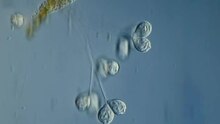Zoothamnium
| Zoothamnium | ||||||||||||
|---|---|---|---|---|---|---|---|---|---|---|---|---|

Zoothamnium arbuscula |
||||||||||||
| Systematics | ||||||||||||
|
||||||||||||
| Scientific name | ||||||||||||
| Zoothamnium | ||||||||||||
| Ehrenberg 1838 |
Zoothamnium is a genus from the group of ciliate animals . The protozoa , which isrelatedto the family of the bell bells (Vorticellidae),are 50 to 120 micrometers in size and live worldwide in the sea and in brackish water, but can also occur in fresh water. Usually several individual individuals sit branched on a common stalk and form growths of usually 2 to 3 millimeters in height, which are visible to the naked eye. However, the colonies can also reach a height of several centimeters. But there are also species that do not form such colonies.
features
The individual cells of the different species are conical to almost spherical. They have a stalk at the narrow lower end through which they are connected to the other individuals of the colony or sit on the base. A contractile muoneme runs centrally in this stalk, which can extend into the cell bodies of the individual individuals.
Colonies
This contractile band, which also branches out and runs through the stalks of the entire colony, enables not only the individual individuals but the entire colony to contract suddenly. The stems are folded in a zigzag pattern, unlike the related genus Vorticella from the Vorticellidae family, in which the stems shorten in a spiral. The zoothamnium species can also be distinguished from the vorticelles with elongated stems, since in these the contractile ligament runs sinusoidally through the stalks when extended.
The sessile zoothaminia have lost all eyelashes, except for the cilia of the oral system. These form a ring of lashes that winds around the unicellular organ's mouth and spirals towards a narrowing funnel. This ends at the cytostome , where the food is taken up and digested in the food vacuoles.
Enthusiast
The individual individuals can also form swarmers (Telotroch), which break away from the colony and swim freely. In this case, cell division forms a cell with a wreath of trochal cilia, with the help of which the swarmers move in the water in order to settle again in a favorable place.
Way of life
Zoothamnium feeds on bacteria. The colonies live in nutrient-rich places in shallow water or as ectocommensals on small crabs or larger animals such as mussels or turtles .
In the hydrogen sulfide-rich habitat, especially in mangrove swamps, Zoothamnium niveum lives in symbiosis with chemoautotrophic sulfide-degrading bacteria . As epibionts, these cover the entire surface of the colonies of Zoothamnium niveum . Elemental sulfur causes the bacterial growth to turn white. This white has led to the species name niveum ( Latin : niveus ; German: snow white) for the Zoothamnium species.
literature
- Sachiko Nagasawa: Asexual Reproduction of the Stalked Ciliate Zoothamnium Attached to the Copepod Centro pages abdominalis . Proceedings of the Japan Academy, Ser. B: Physical and Biological Sciences, 63 (3). Pp. 101-103, 1987 doi : 10.2183 / pjab.63.101
- Denis H. Lynn: The Ciliated Protozoa: Characterization, Classification, and Guide to the Literature . 3rd edition, Springer, New York 2008

